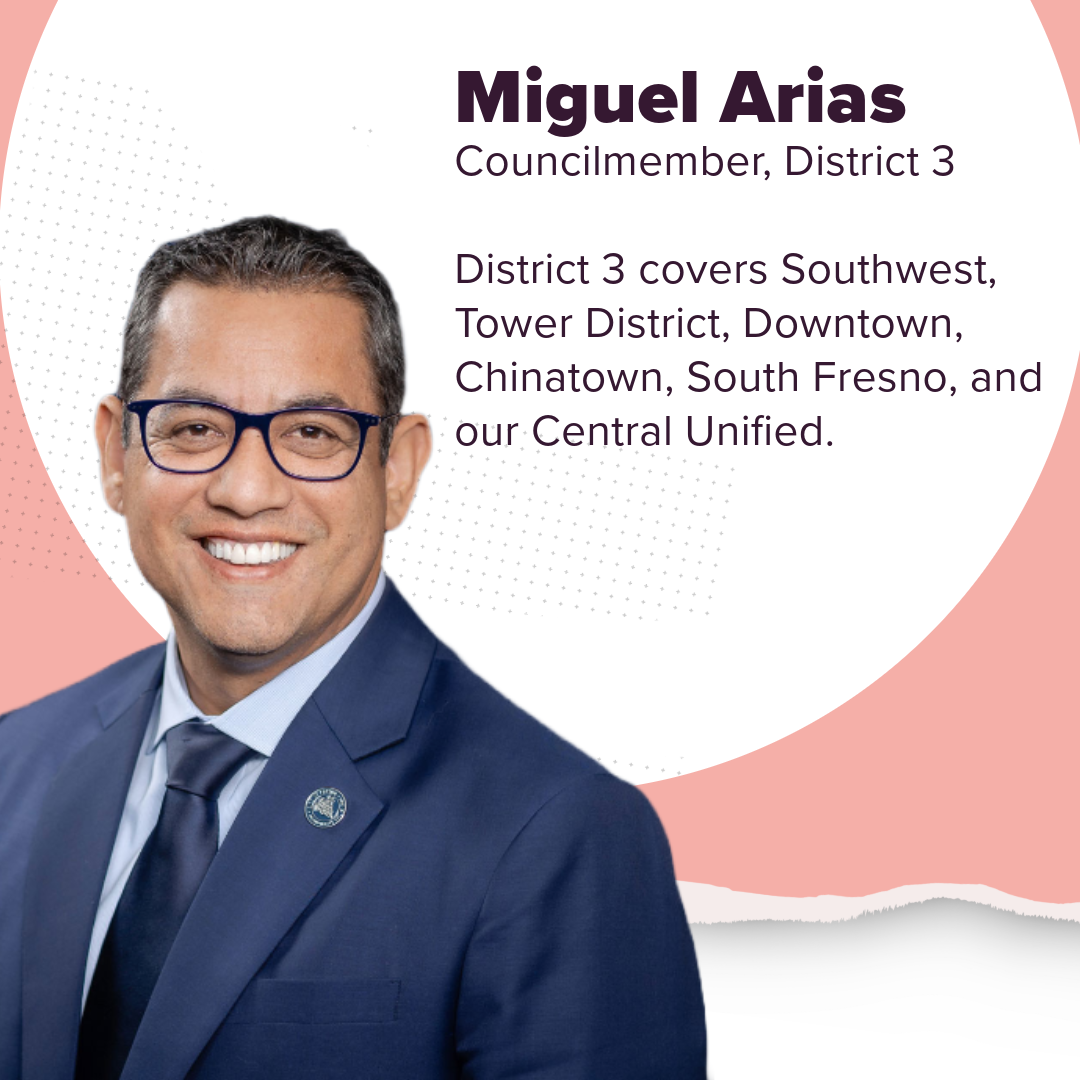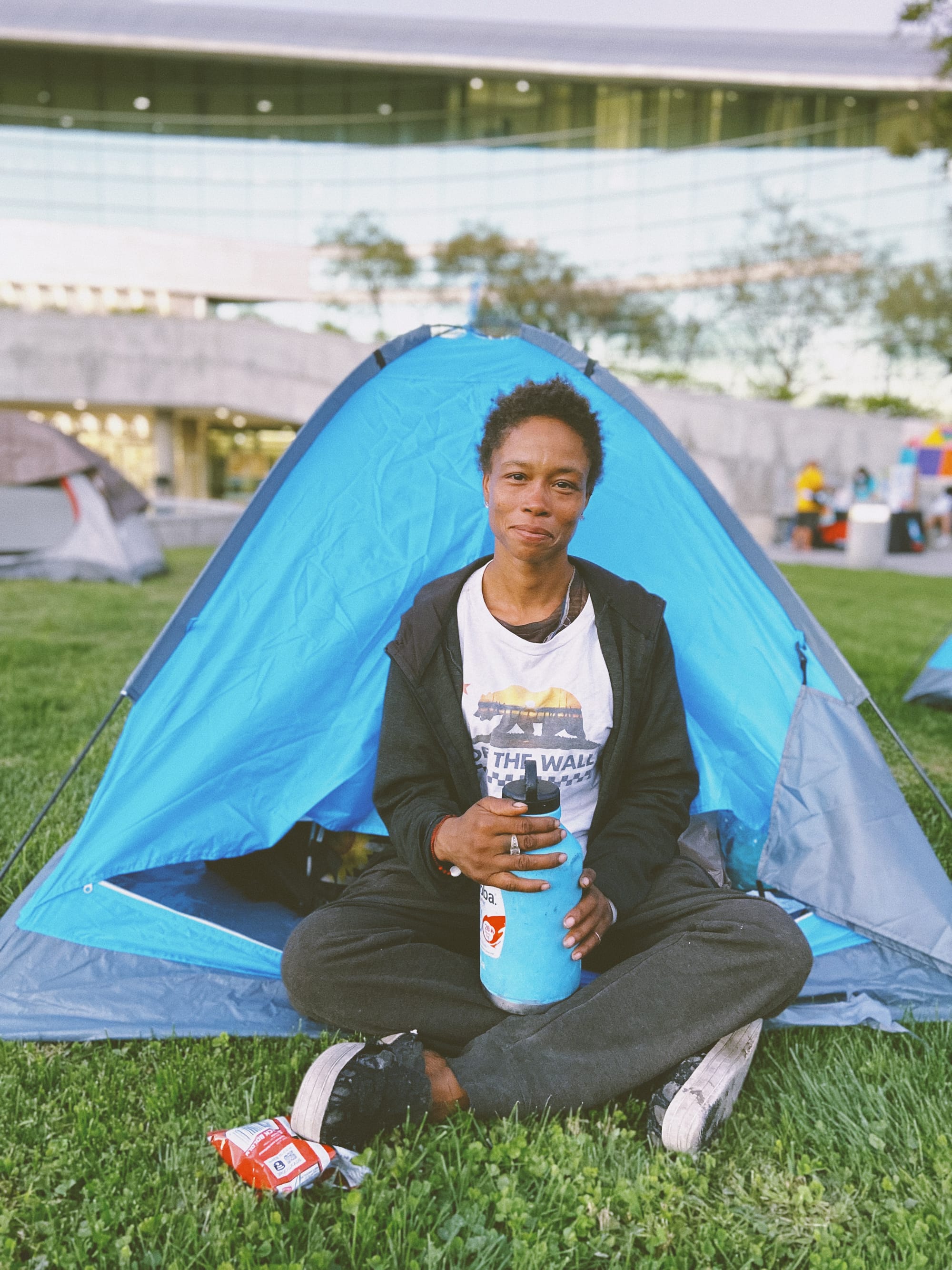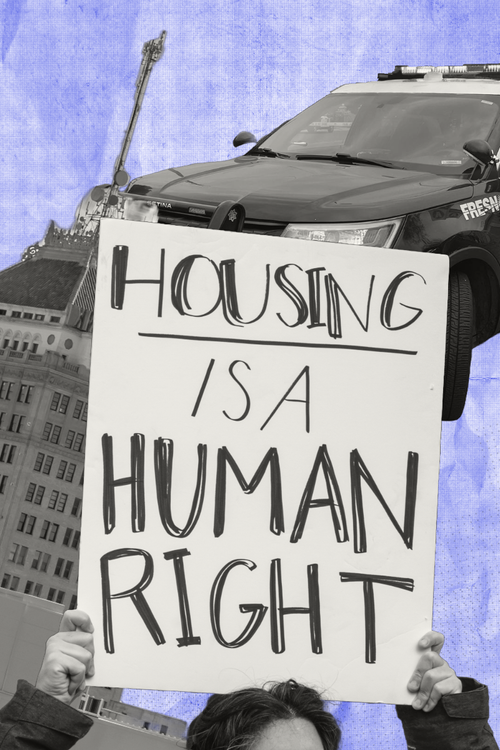She felt it in her fingers first. Icy winds on a winter night in Fresno stung her hands and turned the skin under and around her nails blue. Dawn Sturdivan, a 52 year-old unhoused woman, struggled through another night outside with no access to the city’s warming centers. After the stinging, came numbness in her arms and legs. Blue fingers and ceaseless pain would soon become routine for Dawn in the wintertime. Eventually, she was diagnosed with Raynaud’s Disease–a condition characterized by narrowing arteries and a lack of blood flow to affected areas. That night, when Dawn’s hands and feet went numb, she found solace by dipping them in the warm water she heated over an open fire. Dawn later used that fire to prepare dinner for her unhoused community.
In April of 2024, Councilmember Miguel Arias, serving Fresno’s District 3, introduced a resolution declaring “outdoor warming fires to be a health and safety hazard and a public nuisance.” If passed, the proposed policy would ban open fires throughout the city. Although the resolution doesn’t directly reference Fresno’s unhoused, they are its primary targets.

The fires serve a greater purpose than simply warming Dawn’s hands. They’re used for cooking food, boiling water, and establishing a sense of community among the city’s homeless. Above all, the fact that the unhoused rely on open fires in the first place reveals to us that Fresno’s homelessness policies aren't working.
What consequences would there be to prohibiting open fires for the unhoused? Arias argues none. His resolution justifies the ban by claiming that the warming centers “render outdoor fires unnecessary as a source of heat.” Arias is arguing that Fresno’s warming centers adequately address the needs of the unhoused and can serve as a replacement to open fires. But this idea doesn’t reflect reality.
This past winter, it was clear that the warming centers did not “render the outdoor fires unnecessary.” Fresno City Council established a system that makes the centers extremely difficult to access.
“There aren’t enough of them,” Dawn sat with me to discuss her first-hand experience with the warming centers over tea and furrowed brows. “They’re not like Starbucks on every block,” she added and took a sip.
Even in cases where one of the four centers had a vacancy this winter, many of Fresno’s unhoused were unable to access transportation to the centers. The city assigned its bus system to help people get to the centers. However, this wasn’t sufficient, considering the city bus hours are limited throughout the day and out of service on holidays. Moreover, many of the unhoused are physically disabled and struggle to reach the sparse bus stops in town.
The Fresno City Council added to the list of obstacles facing the warming centers. The council members voted to restrict access to the centers unless temperatures reach below 35 degrees Celsius. As a result, in the entire 2023-2024 winter season, the warming centers were only open three days. The limits to the warming centers are a micro-representation of Fresno establishing systems that boast good intentions while quietly disrupting communities.
Despite being granted funds to specifically address homelessness in Fresno, our City Council’s solutions are facades; vacant vehicles for justice. If the council cared to implement the warming centers correctly, the centers would be open year-round. There would be more centers with effective transportation systems attached to them. The centers would maintain trained and compassionate staff servicing them. If our city leaders meant what they said about ending homelessness in Fresno, the warming centers could have been one small part of a plan to “render outdoor fires unnecessary.” If our elected officials published realistic policy, the centers could have supported Fresno’s unhoused to fulfill their basic needs–a necessary baseline to reintegrate into society. Instead, the centers are a set-back.
At first glance, it might still seem reasonable to prohibit open fires in the city. Regardless of the fact that the warming centers aren’t an adequate replacement, the fires could result in issues for Fresno. Why shouldn’t the city do everything it can to prevent incidents or air pollution? It should. Unfortunately, despite its appearance, the proposed resolution does not actually protect Fresno. Instead, it potentially criminalizes the unhoused, requires impossible policing, and masks the root of the problem.
“We know it needs to be contained,” Dawn spoke about her experiences in the unhoused community. “The fire needs to be stable in a container,” she added, “We all know this.” Dawn explained that most of the unhoused conduct their open fires safely. It is in their interest to keep the fires contained so that they can provide for themselves. She implied that they take extra precautions to avoid spreading fires and causing commotion. Dawn took a deep breath, “the normal homeless person that lives here doesn’t want to be seen.”
Confirming Dawn’s statements, the Fresno Fire Department usually doesn't put out contained fires started by the unhoused. The department permits the unhoused to wield open fires as long as they are contained. Currently, open fires are allowed as long as they are safe and used for specific purposes, like cooking.
So, safety isn’t a significant concern. What about Fresno’s air? Would this resolution prevent pollution like it suggests? Brandi Nuse-Villegas, a community advocate and artist, doesn’t think so. “What about the people who have fires at the park or tailgate?” Brandi pointed out. She notes that the proposed resolution isn’t overtly directed at the unhoused. Open fires happen throughout the city for a variety of reasons and have never been criminalized. Brandi added that despite the ambitions of Arias’s resolution, the city cannot, in reality, control backyard or house fires, “so it is clearly written to target the homeless.”
Still, fires of all kinds pollute the air and accidents happen. Something does need to be done. However, it’s evident that the resolution sponsored by Miguel Arias and supported by Gary Bredefeld is not the solution Fresno needs. On the contrary, the resolution worsens the city’s issues.
It mirrors Fresno's broader approach to homelessness policy: exacerbate conditions for the homeless, request more funding, rinse and repeat.
Throughout the interview, Dawn and Brandi returned to one clear message: Despite Fresno City Council expressing goals of solving homelessness, their city policy says otherwise. The most prevalent example they shared to expand on this statement was a city agency called the Homeless Assistance Response Team (HART). HART is composed of multiple departments including a team of specially trained Fresno Police Department officers. According to Pastor Harold Spees, former Director of Housing and Homeless initiatives, the HART Team was designed to “provide protection for homeless individuals living in encampments.” Proponents of HART claim that the agency aids “unhoused people and families with compassion and empathy.”
HART’s actions on the ground tell a different story. Rather than supporting the unhoused, HART is “hindering people from getting off the streets” according to Brandi. They are often seen destroying the unhoused’s property, discarding their food, taking their stove tops, displacing them, and taking them into custody for petty reasons. HART claims to offer beds and shelter, but after performing encampment sweeps, there are only two shelter beds available per week on average. Dawn described HART as “basically martial law.”
Video of HART taking the backpacks and other important personal belongings of unhoused community members, including their IDs and medication. Credit: Homeless In Fresno
One week after interviewing Dawn, she was targeted by HART. They stole all of her belongings, including her tent, blanket, donations, and her dog’s food. HART’s reason? She was “taking too long” to follow orders.
HART’s operations are funded by our tax dollars and Fresno Mayor Jerry Dyer is a staunch proponent of the department. This city-funded agency is another clear example of the systemic ways Fresno targets the unhoused and ultimately feeds the homelessness cycle. How do our unhoused progress when a group of Fresno PD takes their property, displaces, and arrests them every few weeks–all in the name of “compassion and empathy?” How do they secure their basic human rights?
So if the city’s systems aren’t helping the unhoused, what are they doing? What might our council gain from perpetuating homelessness?
In April, Governor Newsome granted Fresno another $10.9 million from the state’s Encampment Resolution Funding (ERF) program. Newsom praised Mayor Jerry Dyer’s work, adding “Jerry does not need to be told that he’s done an extraordinary job.” Ironically, Newsome honestly cannot say whether Jerry deserves the money or not. A recent audit found that California has not consistently “tracked and evaluated the State’s efforts to prevent and end homelessness.” This includes efforts in our city. Ultimately, the Newsom is showing us that whether Fresno’s systems are effective or not, we will be rewarded. And it isn’t entirely clear how the city is using that reward money.
The state’s blatant lack of transparency and funding misuse can be tracked down to the city level, according to Dez Martinez, the founder of We are Not Invisible and a formerly homeless person. In an interview, Dez expressed that the City of Fresno and the Continuums of Care (CoC), a government program to address homelessness, are not always clear on how money for the unhoused is being spent. She added that “nobody pays attention to the homeless funds, because they don’t care about the homeless.” Dez recalled that the CoC used funds to install lamp posts in the city and kept a lot of their spending in the dark. “What is a street lamp post doing for us?” Dez laughed.
Although experts aren’t clear on what caused Raynaud’s Disease in Dawn, they’ve confirmed the disease’s symptoms are triggered by extreme cold or stress. With Fresno on the cusp of an open fires ban, funding the HART team, and implementing flawed policies, Dawn is facing far more than cold and stress.
I asked Dawn what the people of Fresno can do to support her and others navigating similar circumstances. She paused before answering, “Imagine the people that are homeless as children. We are human. We were people before we ended up out here.”

The Fresno community can impact the outcome of the open fires resolution. Attend Fresno City Council meetings and demand that your council members vote no on the resolution to ban open fires. Remind Fresno City Council of alternative solutions to open fires like portable stove tops and regular access to warming centers. Ask your city council to propose policies that address the root of the issues for the unhoused.
You can also get involved in advocacy work for the unhoused. Volunteer with Dez at We Are Not Invisible–a local nonprofit “seeking to serve the homeless community.” Donate to their Project H2o wishlist, which will be especially useful in the upcoming summer weeks. For those interested in systemic change and policy work, consider joining the movement at Power California. Learn more about Faith in the Valley and their work towards affordable housing in Fresno and other causes.

